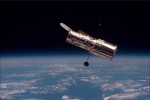UCLA researchers are examining the origins of the universe’s oldest galaxies through a joint project with NASA.
The Grism Lens-Amplified Survey from Space uses NASA’s Hubble Space Telescope to collect data about elements in faraway galaxies, said Tommaso Treu, principal investigator of the project and a physics and astronomy professor at UCLA. GLASS researchers published a study last month about the chemical conformation and star formation rate of a galaxy formed shortly after the Big Bang.
“It’s like taking baby pictures of the universe,” Treu said. “When we’re looking at something 13 billion light years away, we see it from 13 billion years ago.”
Treu said from 2013 to 2015, researchers from UCLA and other universities collected data from 20,000 galaxies and are currently analyzing and verifying the data. He added the GLASS data is helping researchers understand how the first galaxies produced light and elements.
By finding elements in old galaxies, researchers can find out how the first galaxies formed stars and made heavy elements like carbon out of hydrogen and helium, Treu said.
“The data tells us about how the universe went from a blob of hydrogen into what you see when you look at the sky,” Treu said.
Treu said he was interested in observing the early universe for a long time, but was unable to access the Hubble telescope. He added it was not until he collaborated with other researchers at UCLA that he was able to submit a competitive project proposal to access the telescope.
Matt Malkan, a GLASS researcher and physics and astronomy professor, said researchers tend to focus on only the biggest and brightest galaxies in the universe. He added GLASS pushes the Hubble telescope to its limits by focusing on smaller and dimmer galaxies billions of light years away that are often overlooked.
“The biggest excitement is looking in detail at a very, very distant galaxy that turns out to be interesting,” Malkan said. “Their star clusters are a gold mine of data.”
Treu said researchers used Hubble to take pictures of the galaxies’ light spectrums. By analyzing a galaxy’s light spectrum, researchers can see what elements the galaxy contains because each element gives off light of a certain wavelength, he said.
“We can map out where different elements are in galaxies to a level of detail that hasn’t been done before,” said Charlotte Mason, a GLASS researcher and graduate student in astronomy and astrophysics.
Mason said researchers still need to verify the existence of the faraway galaxies they observed using other telescopes. Mason currently observes these same galaxies through the W. M. Keck Observatory’s telescopes, which were also designed by UCLA researchers.
Malkan said he is excited for the launch of NASA’s new James Webb Space Telescope, which will also focus specifically on distant galaxies formed right after the universe’s birth. According to NASA, it is set to launch in October 2018.
